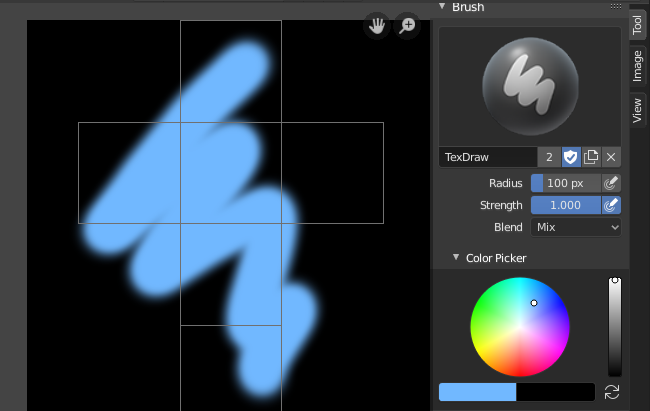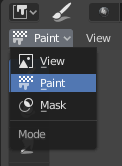Introducción¶
A UV texture is a picture (image, sequence or movie) that is used to color the surface of a mesh. The UV texture is mapped to the mesh through one or more UV maps. There are three ways to establish the image used by the UV texture:
Use any image editing program to create an image. In the Image Editor, select the UV texture and load the image. Blender will then use that texture’s UV map to transfer the colors to the faces of the mesh.
Paint a flat image in the Image Editor onto the currently selected UV texture, using its UV map to transfer the colors to the faces of the mesh.
Paint the mesh in the 3D Viewport, and let Blender use the currently selected UV map to update the UV texture (as discussed below).
Blender features a built-in paint mode called Texture Paint which is designed specifically to help you edit your UV textures and images quickly and easily in either the Image Editor or the 3D Viewport. Since a UV texture is just a special-purpose image, you can also use any external paint program, like GIMP or Krita.

Pintado de texturas en Blender.¶
Since a mesh can have layers of UV textures, there may be many images that color the mesh. However, each UV texture only has one image.
Texture Paint works in both a 3D Viewport and the Image Editor. In the 3D Viewport in Texture Paint Mode, you paint directly on the mesh by projecting onto the UVs.
Truco
Optimización de memoria
Texture Paint is fast and responsive when working in the 3D Viewport and when your image is sized as a square where the side lengths are a power of two, e.g. 256×256, 512×512, 1024×1024, etc.
Primeros pasos¶
The object to be painted on must first be unwrapped. UVs can be added traditionally, with standard Unwrapping Tools, or by adding Simple UVs in Texture Paint mode.
Nota
When no UV layers can be detected, Blender will display a warning message.
Once you have unwrapped your model to a UV map, you can begin the texturing process. To use texture paint you may do any of the following:
Activate the Texture Paint workspace. Here the 3D Viewport has the Texture Paint Mode enabled and the Image Editor is already switched to Paint mode.
In the 3D Viewport, select Texture Paint Mode from the mode selector in the header, and you can paint directly onto the mesh.
In the Image Editor, switch the mode to Paint (shown in the image to the right).

Habilitación del modo de Pintura.¶
Once you enable Texture Painting, your mouse becomes a brush. As soon as you enable Texture Painting or switch to Texture Paint Mode, different tools become available in the Toolbar.
In the Image Editor, you paint on a flat canvas that is wrapped around the mesh using UV coordinates. Any changes made in the Image Editor show up immediately in the 3D Viewport, and vice versa.
To work with the UV layout (for example, to move coordinates) you must use the Editor de UV.
A full complement of brushes and colors can be selected from the Sidebar region in the Image Editor. Brush changes made in either panel are immediately reflected in the other panel. However, the modified texture will not be saved automatically; you must explicitly do so with Save Image.
Previsualización de texturas¶
If your texture is already used to color, bump map, displace, alpha-transparent, etc., a surface of a model in your scene (in other technical words, is mapped to some aspect of a texture via a texture channel using UV as a map input), you can see the effects of your painting in the context of your scene as you paint.
To do this, set up side-by-side areas, one Area in 3D Viewport set to Texture shading option, and in the second Area the Image Editor loaded with your image. Position the 3D Viewport to show the object that is UV-mapped to the loaded image. In the image to the right, the texture being painted is mapped to the «Normal» attribute, and is called «bump mapping», where the grayscale image is used to make the flat surface appear bumpy. See Texture Mapping Output for more information on bump mapping.
Guardar¶
If the header menu item Image has an asterisk next to it means that the image has been changed, but not saved. Use Save Image or Save Image As to save your work with a different name or overwrite the original image.
Nota
Texturas UV
Since images used as UV textures are functionally different from other images, you should keep them in a directory separate from other images.
The image format for saving is independent of the format for rendering.
The format for saving a UV image is selected in the header of the File Browser,
and defaults to PNG (.png).
If Packing is enabled in the File Browser’s header, or if you manually pack, saving your images to a separate file is not necessary.
Uso de un editor de imágenes externo¶
If you use an external program to edit your UV texture, you must:
Run that paint program (GIMP, Krita, etc.).
Cargará la imagen o creará una nueva.
Cambiará la imagen.
And re-save it within that program.
De vuelta en Blender, recargar la imagen en el Editor de imágenes.
You want to use an external program if you have teams of people using different programs that are developing the UV textures, or if you want to apply any special effects that Texture Paint does not feature, or if you are much more familiar with your favorite paint program.
Limitaciones conocidas¶
Superposición de UV¶
En general la superposición de UV no está soportada (al igual que sucede al capturar texturas).
Sin embargo, esto sólo representará un problema cuando un único trazo de pincel pinte sobre varias caras que compartan una misma textura.
La vista en perspectiva y caras fuera de la vista¶
Al pintar sobre una cara que esté parcialmente fuera de la vista (en modo perspectiva), la cara no podrá ser pintada. Para evitar esto, se recomienda alejar la vista o usar una vista con proyección ortogonal.
La vista en perspectiva y bajos polígonos¶
Al pintar sobre una cara en modo perspectiva sobre un objeto de bajos polígonos con sus normales apuntando en la dirección opuesta a la de la vista, la pintura podría fallar; para evitar esto desactivar la opción Decaimiento según normales en las opciones del Trazo.
Normalmente esto sucederá al pintar sobre uno de los laterales de un cubo (ver Blender error #34665).